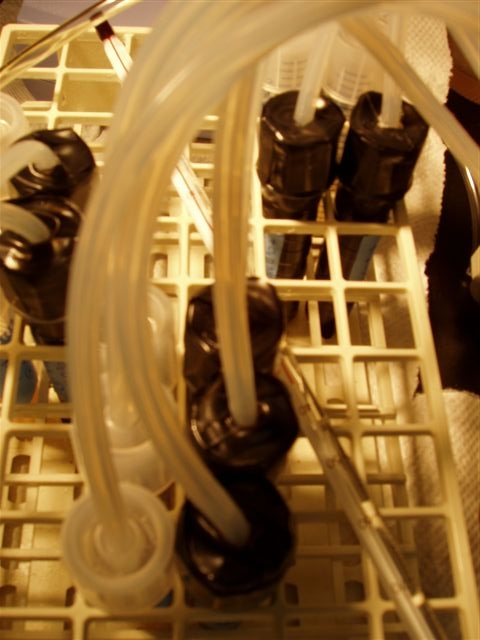|
In our second lab, the Bacteriorhodopsin Growth Lab, we attempted to obtain a better understanding of the nature of bacteriorhodopsin by varying the environment in which the Halobacterium is grown. More specifically, we wanted to determine how a lack of light will affect Halobacterium growth in aerobic and anaerobic conditions.Using a dizzying array of flasks, electrical tape and aerators, we simulated a range of various environmental variables including anaerobic dark, anaerobic light, aerobic light and aerobic dark. Each environment was then remplicated in two isolated flasks, one to be tested for optical density (OD) after 24 hours and the other to be tested after 48 hours.
|
 |
The data that we gathered seems to indicate that the Halobacterium cultures grew more rapidly between 24–48 hours than they did between 0–24 hours. A factor which we could easily attribute to the exponetial growth pattern of Halobacterium.
Overall, the Dark aerobic cultures of 1.088, a net increase of 0.549. The Light aerobic cultures fared similarly, reaching a final OD of 1.028, indicating a net growth of about 0.489. Although below the Dark aerobic cultures in terms of net growth, the Light aerobic experienced the most growth between 24 – 48 hours. However, this result could also be termed questionable due to noticeable liquid loss (about 5mL) in the 48 hour flask. |
|
The Dark anaerobic group in fact did experience some net growth, totaling to around 0.002 over 48 hours. This fact could perhaps be attributed to the Halobacterium’s ability to undergo arginine fermentation in order to survive. This assumption, however, calls into question why the Light anaerobic had not acted in a similar fashion. Moreover, the net growth, again, is so small that it could easily have been within the margin of error (last significant digit…) Therefore, the net growth could quite reasonably be considered zero.Considering the net growth, the Light anaerobic group fared worst, decreasing in OD by about 0.082 over 48 hours. However, there was a slight increase of about 0.023 between day two and day three, which could indicate a very slight growth curve. The other option to consider, however, is the fact that the data points for the two days were not drawn from the same sample but instead, two isolated samples that could potentially have had slightly different OD to begin with. Thus, such small difference could only be disregarded and net growth for the entire group could potentially be regarded as zero.
|
|
